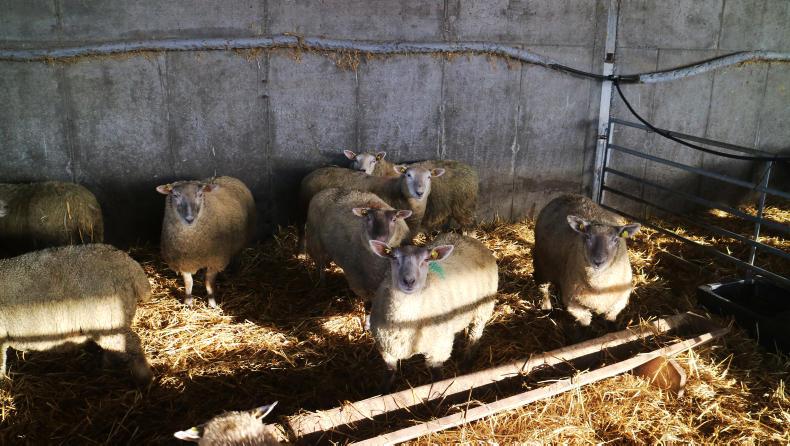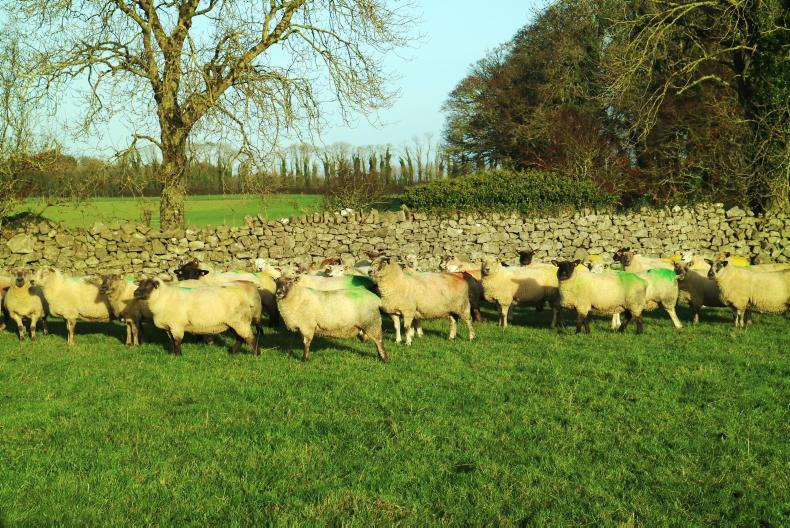Following completion of the stocking rate and prolificacy trial, the research demonstration flocks in Teagasc Athenry are moving into new territory and assessing the potential role of clover in grass-based sheep production systems.
Lead researcher with the trial Philip Creighton explains: “The stocking rate and prolificacy trial provided a lot of valuable information on the level of output and more importantly the gross margin attainable from varying stocking rate and prolificacy levels.
“We have focused on these results in setting up the new trial - the stocking rate of 14 ewes came out on top in terms of gross margin, but it is more exposed than the 12 ewes/ha system and requires higher concentrate input.
“Therefore, we have selected a stocking rate of 13 ewes per hectare for one group to see if this is the best balance and 11 ewes per hectare for the other to see what level of output can be achieved for farmers that maybe cannot push to 12 ewes/ha and higher.”
These stocking rates will be assessed under three different pasture types. The first is the control and is a grass-only sward receiving 145kg/ha chemical nitrogen per year. The second is a grass plus white clover sward also receiving an annual allocation of 145kg/ha chemical nitrogen, while the last is also grass plus white clover sward but receiving a lower annual allocation of 90kg/ha chemical nitrogen.
Philip says: “We are looking at how clover will influence a number of key production variables, including the influence it will have on ewe and lamb performance, pasture production throughout the year, the levels of utilisation achieved and the quality of the sward.
“We are interested in seeing if the swards including clover can support higher stocking rates and if clover will compensate for the lower level of nitrogen applied in the third treatment.”

The grass plus clover swards have clover incorporated at an average rate of 20%, which will increase to about 30% to 40% in August and September due to clover’s increased growth rate at that stage of the year.
It is also hoped that this will positively benefit lamb performance and help increase the number of lambs finished off a pasture-only diet.
Early days
As the trial is only in its first year, it is early to make any definitive statements regarding performance. The data presented is preliminary data and has not yet been statistically analysed. However, Philip says there are encouraging signs that there is a benefit from incorporating clover.
Table 1 details the performance of lambs drafted up until the first week of November. Lambs grazing on the grass plus clover swards achieved an average daily gain from birth to slaughter of 225g/day compared with 219g/day for lambs grazing on the grass-only swards.
While it may be small, the difference had been higher in September and October prior to increasing concentrate supplementation and housing, when up to 17% more lambs had been drafted from grass clover groups. The difference in the drafting rate up until the end of October was 11%, with 81% of lambs grazing the grass plus clover swards drafted and 70% in the grass-only.
Stocking rate
Table 2 details the breakdown in lamb performance on a stocking rate basis. As can be expected, the lambs in the lower 11 ewes/ha stocking rate achieved higher performance with less pressure on these animals during the grazing season.
Lambs at the lower stocking rate achieved a marginally higher performance of 224g/day versus 221g/day, but it must also be pointed out that there will be significantly more lambs available for sale in the higher stocking rate flocks.
Breeding performance
Ewes in the trial have been carried through from the stocking rate and prolificacy trial with medium and high prolificacy ewes balanced to deliver a weaning rate of 1.6 lambs per ewe. Breeding commenced on 10 October and finished last Tuesday (14 November), giving a five-week breeding period. The breeding pattern was more even this year over the first three-week period compared with the majority of ewes being front-loaded to the first two weeks in previous years.
There was one group with a repeat rate of about 10% of ewes, but it is not easy to identify the reason, with rams switched regularly between groups and no other groups experienced issues when joined with this ram.
Similar to lambs, there were also differences in ewe performance between the two stocking rates, with ewes at 13 ewes/ha commencing breeding at body condition score of 3.0 compared with 3.2 for the lower stocking rate group. Philip explains that this is about 0.25 of a condition score behind the start of breeding in previous years and reflects the challenging weather the flock has faced in recent months.
“Grass growth rates have been good this year. The problem has been utilisation. The dry matter of grass averaged 15% in summer when it should have been in the region of 17%. The gap got even bigger in autumn, with the dry matter dropping to just 13.5% when normally it would be about 16% or higher. This had knock-on effects for ewe and lamb performance as intake, as well as utilisation, was compromised.”
Indoor finishing
The high rainfall levels and poor grass utilisation and dry matter culminated in lower performance of lambs and ewes and a higher number of lambs being present in September, with drafting rates running 10% to 15% behind average levels achieved in previous years. To counteract this, meal was introduced at a rate of 0.25kg per head to lambs in mid-September, quickly rising to 0.5kg.
Philip says that meal feeding helped sustain performance, but it still was not great, with lambs walking a lot of grass into the ground. With a fear of grass supplies running tight for ewes, a decision was taken to house lambs in mid-October, just ahead of ex-hurricane Ophelia.

Lambs were offered higher concentrate supplementation of 0.7kg, split over two feeds, and ad-lib high-quality silage made from surplus paddocks.Performance over the first couple of weeks while lambs were adjusting to an indoor environment was recorded at about 160g to 170g and has since improved to 220g at the last weighing, with lambs benefiting from a lift in dry matter intake.
There were about 140 lambs in total housed at an average of 39.9kg, with 60 of these drafted last week.
 Another 40 should be ready for drafting in the next week, with slaughter performance of lambs also significantly improving, with the kill-out rising 2% to 3% to an average of 45%. Lambs are being drafted once they exceed 45kg and have a sufficient cover of flesh and this is delivering a carcase weight of 20kg.
Another 40 should be ready for drafting in the next week, with slaughter performance of lambs also significantly improving, with the kill-out rising 2% to 3% to an average of 45%. Lambs are being drafted once they exceed 45kg and have a sufficient cover of flesh and this is delivering a carcase weight of 20kg.
The higher than normal temperatures had made it harder for lambs to settle indoors, but they now seem to be better acclimatised.
The only slight concern is a higher risk of lameness, with lambs footbathed at least every two weeks to keep on top of any issues.
Grass growth
As mentioned previously, grass growth has been positive in 2017. The total volume of grass grown to the end of October was recorded at 12,881kg DM/ha in the grass-only swards, with 13,480kg DM/ha of herbage grown in the grass plus white clover swards, a difference of 600kg DM/ha.
Looking at the two white clover treatments, Philip says there was very little difference between the two with the low nitrogen treatment actually growing slightly more at 13,495kg DM/ha versus 13,466kg DM/ha.
However, the picture at the end of the year could be different, with the final application of nitrogen applied before closing and potentially giving a lift to grass growth on swards closed for grazing next spring.
Looking at the volume of grass produced for grazing and silage, the grass-only swards produced 10,086kg DM/ha, with the grass and white clover swards producing 1,173kg DM/ha more, with very little difference again between white clover treatments, with the high nitrogen treatment this time coming out on top.
On a stocking rate basis, the swards being grazed by the lower stocking rate produced 12,841kg DM/ha (10,346kg DM/ha grazing), 879kg DM/ha lower than the high stocking rate group at 13,720kg DM/ha (11,390kg DM/ha grazing).
The farm has sufficient fodder saved, with a 30% surplus in the low stocking rate group and an 8% surplus in the high stocking rate group. This is based on a 100-day winter, with an average dry matter silage intake of 1.3kg DM/head/day and 30 days feeding for lambs with an average intake of 0.7kg DM silage.
Grazing management
Utilisation has lifted slightly in recent weeks and is helping to get paddocks grazed out to the desired height of 3.5cm to 4cm.
Philip says that he skipped some heavy covers in recent weeks to keep on target with closing covers and improve utilisation, with heavier covers coming on stream now. Utilisation in these is being aided by splitting paddocks with temporary electric wire.


The farm is ahead of target to have 20% of each grazing area closed by mid-October, 40% by early November, 60% by mid-November and 80% by early December, with ewes likely to be housed in mid-December in the high stocking rate group and around Christmas in the lows.






 This is a subscriber-only article
This is a subscriber-only article












SHARING OPTIONS: